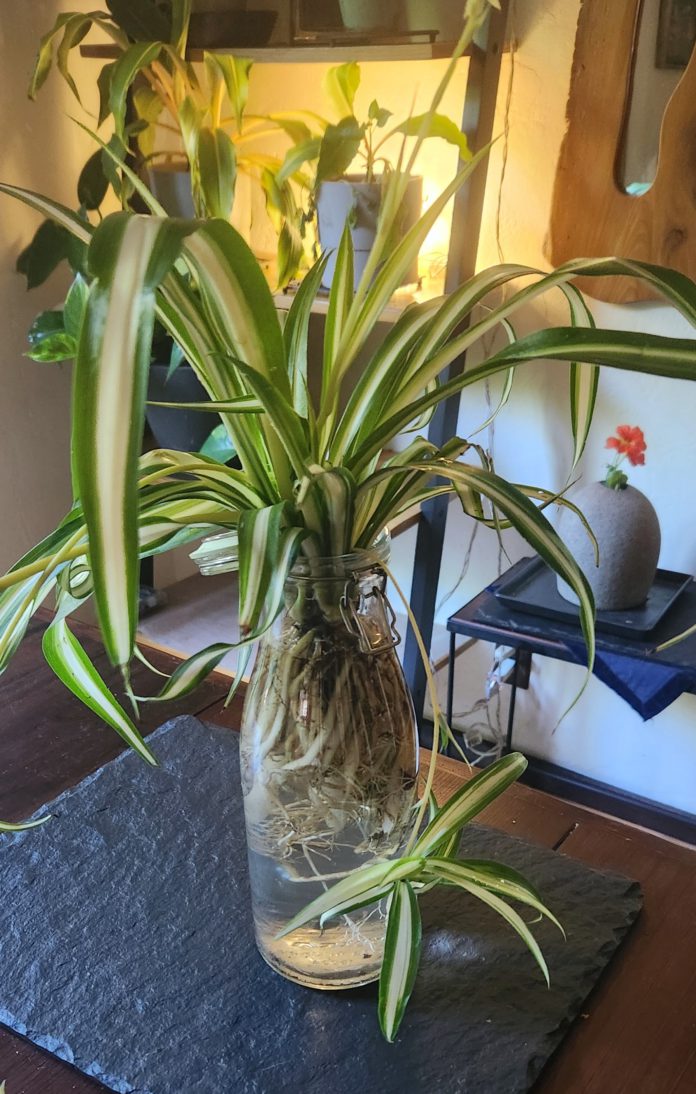By Daniel O’Donnell
Most companies go to great lengths to hide the hardware of their products. However, some companies and enthusiastic hobbyists make an effort to display the inner workings of something they are passionate about. This is done by replacing cases and covers with clear plexiglass or plastic. One of the best examples is when classic car enthusiasts install plastic hoods that show off their cars’ ostentatious engines. Swatch makes a clear watch case that shows the inner workings of the timepiece. There are also companies online that will replace a computer case with a clear one so the components can be appreciated as art. Growing houseplants in transparent containers of water makes it possible for plant lovers to be included in this type of design.
Not all houseplants can be grown in water, but many can by using a simple hydroponic method. There is no need for the pump, filter, and piping larger hydroponic systems use. The only infrastructure needed to grow a single houseplant or two is a clear glass or plastic container. No soil is necessary, only water. Roots are submerged in the water and foliage grows above it. Most plants can thrive in tap water. However, some may be sensitive to the chemicals. Filtered water or stored rainwater can be used in place of tap water. Distilled water is fine but lacks minerals, so it should be used in conjunction with a houseplant fertilizer.
The benefits of growing certain houseplants in water are that they do not have to be regularly watered, the humidity around the foliage is increased, and the root systems create an intriguing visual display. Plant care routine is simplified by not having to replace the soil whenever it gets depleted and there are no harmful soil-dwelling fungi, molds, or insects to contend with. Some hydroponically grown houseplants do not need to be fertilized, and for those that do it is as easy as adding a few drops of houseplant fertilizer at the interval recommended. Fertilizing in a water medium, as opposed to soil, distributes the nutrients more evenly.
Growing houseplants in water can create an alluring piece of living art. A clear container allows usually-unseen root systems to be viewed, and has functional purposes too. Water clarity and algae buildup can be monitored more easily in a transparent receptacle. Water should be changed as soon as it looks a little cloudy. The container should be emptied and walls wiped clean at the first sign of algae formation. A clear container also allows for a visual inspection of the root system. Overcrowding, underdevelopment, and the overall health of the roots can be continuously observed.
Other factors for choosing the proper container include the depth, size, and shape. This will depend on the characteristics of the plant such as root length and foliage height and width. The proper container should be deep enough to cover the entire root system. It should be proportional to the plant size and offer enough volume to sustain the plant for at least a week before having to add more water. The container can be both functional and aesthetic as long as it fulfills the plant’s requirements. Receptacles with larger openings are much easier to clean, add water, and incorporate gravel, driftwood, and other components that complement indoor hydroponic features. Purchasing a bottle brush and small funnel will make cleaning and adding water to containers with small openings easier.
Houseplants that succeed in water include:
Spider plant, Chlorophytum comosum, known for its arching white stripe leaves and baby spider plantlets. It grows well in water and has the added benefit of being excellent at purifying indoor air.
Spiderwort, Tradescantia, has many different types that will grow well in water. Popular ones are grown for their purple or variegated lavender foliage. Sometimes referred to as “dayflower” they also produce small flowers that open and close within a day.
Pothos, Epipremnum aureum, is a great plant for growing in water. This vine with heart-shaped leaves thrives inside and can grow up to a foot per month. It has a range of foliage colors from green, to variegated white and green, to variegated yellow and green.
Philodendron, Philodendron, is a popular houseplant and easy to grow in water. It can tolerate lower lighting conditions. Various ones have different leaf shapes which add another layer of intrigue to this hydroponic houseplant.
Moss balls, Aegagropila linnaei, are a species of filamentous green algae that grow and tangle together to form a ball shape. Although they have no roots or out-of-water foliage, they still make intriguing indoor water containers. They can live alone or at the bottom of a houseplant water feature.
There are many other houseplants that can grow well in water. So, dip your toe and your plant into the water and try this simple form of hydroponic gardening.
Daniel O’Donnell is the co-owner and operator of an organic landscape design/build company in Fremont. www.Chrysalis-Gardens.com




